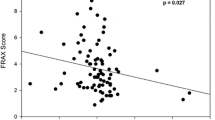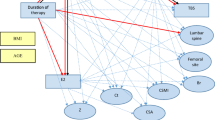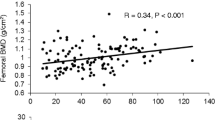Abstract
To determine whether testosterone replacement therapy reverses the detrimental effects of hypogonadism on bone density, we measured the total body, lumbar spine and proximal femur bone mineral density (BMD) by dual-energy X-ray absorptiometry in 14 patients with Klinefelter's syndrome on long-term testosterone replacement therapy and compared the results with 14 age- and sex-matched normal controls. Seven of the patients were receiving oral testosterone undecanoate thrice daily (240 mg/day) and the others were having intramuscular testosterone enanthate injections once every 3 weeks (250 mg/injection). Their serum testosterone levels were maintained within the normal limits (10–40 nmol/l). We showed that patients on testosterone replacement had decreased amount of bone density in the left femoral neck when compared with the controls (p<0.01). Similar decreases were also observed in the left Ward's triangle (p<0.01) and in the left trochanter (p<0.05). There were no significant differences in the total body and the lumbar spine measurements in these two groups of subjects. No correlation was found between the BMD values of femur and the duration of testosterone treatment in the patients with Klinefelter's syndrome. The type of testosterone treatment was also not associated with significant differences in BMD. In conclusion, sufficient testosterone replacement with currently available methods does not reverse the decrease in bone mass associated with hypogonadism in patients with Klinefelter's syndrome.
Similar content being viewed by others
References
Leonard JM, Paulsen CA, Ospina LF, Burgess EC. The classification of Klinefelter's syndrome. In: Vallet HL, Porter IH, editors. Genetic mechanisms of sexual development. New York: Academic Press, 1979:407–23.
Paulsen CA, Gordon DL, Carpenter RW, Gandy HM, Drucker WD. Klinefelter's syndrome and its variant: a hormonal and chromosomal study. Recent Prog Horm Res 1968;24:321–63.
Gordon DL, Krmpotic E, Thomas W, Gandy HM, Paulsen CA. Pathologic testicular findings in Klinefelter's syndrome- 47,XXY vs. 46,XY/47,XXY. Arch Intern Med 1972;130: 726–9.
Winck CS, Felts WSL. Loss of bone tissue and hypogonadism. Can Med Assoc J 1980;123 (2):77–82.
Smith DAS, Walker MS. Changes in plasma steroids and bone density in Klinefelter's syndrome. Calcif Tissue Res 1977; 22 (Suppl):225–8.
Foresta C, Ruzza G, Mioni R, Meneghello A, Baccichetti C. Testosterone and bone loss in Klinefelter's syndrome. Horm Metab Res 1983;15:56–7.
Baran DT, Bergfeld MA, Teitelbaum SL, Avioli LV. Effect of testosterone therapy on bone formation in an osteoporotic hypogonadal male. Calcif Tissue Res 1978;26:103–6.
Cantrill JA, Denis P, Large DM, Neuman M, Anderson DC. Which testosterone replacement therapy. Clin Endocrinol 1984;21:97–107.
Finkelstein JS, Klibanski A, Neer RM, Greenspan SL, Rosenthal DI, Crowley WF. Osteoporosis in men with idiopathic hypogonadotropic hypogonadism. Ann Intern Med 1987;106:354–61.
Sufi SB, Donaldson A, Jeffcoate SL. WHO Reagent Programme: Testosterone Assay. Method Manual 1989:80–92. WHO Special Programme of Research, Development and Research Training in Human Reproduction. Programme for the Provision of Matched Assay Reagents for the Radioimmunoassay of Hormones in Reproductive Physiology. Geneva: WHO.
Pun KK, Wong FHW. Importance of bone density measurement in the management and treatment of osteoporosis. Singapore Med J 1990; 31 (4):152–6.
Pun KK, Wong FHW, Loh T. Rapid postmenopausal loss of total body and regional bone mass in normal Southern Chinese females in Hong Kong. Osteoporosis Int 1991;1:87–94.
Kotzi PO, Harong H, Sabatier JP, Marchadise X, Basse-Carthalinat B, Tourzey C. Comparative performance evaluation of dual energy bone densitometers with a dedicated step phantom. In: Ring EFJ, editor. Current research in osteoporosis and bone mineral measurement. London: British Institute of Radiology, 1990:34–35.
Muller BJ, Krantzler NJ, Grivetti LE, Schultz HG, Miselman HL. Validity of a food frequency questionnaire for the determination of individual food intake. Am J Clin Nutr 1984; 39: 136–43.
Pun KK, Chan LWL, Chung V, Wong FHW. Calcium and other dietary constituents in Hong Kong Chinese in relation to age and osteoporosis. J Appl Nutr 1992 (in press).
Greenspan SL, Neer RM, Ridgway EC, Klibanski A. Osteoporosis in men with hyperprolactinemic hypogonadism. Ann Intern Med 1986;104:777–82.
Rigotti NA, Neer RM, Jameson L. Osteopenia and bone fracture in a man with anorexia nervosa and hypogonadism. JAMA 1986; 256:385–8.
Foresta C, Zanatta GP, Busnardo B, Scanelli G, Scandellari C. Testosterone and calcitonin plasma levels in hypogonadal osteoporotic young men. J Endocrinol Invest 1985;8:377–9.
Foresta C, Busnardo B, Ruzza G, Zanatta G, Mioui R. Lower calcitonin levels in young hypogonadic men with osteoporosis. Horm Metab Res 1983;15:206–7.
Francis RM, Peacock M, Aaron JE, et al. Osteoporosis in hypogonadal men: role of decreased plasma 1,25-dihydroxyvitamin D, calcium malabsorption, and low bone formation. Bone 1986;7:261–8.
Cann CE, Martin MC, Genant HK, Jaffe RB. Decreased spinal mineral content in amenorrheic women. JAMA 1984;251: 626–9.
Drinkwater BL, Nilson K, Chesnut CH III, Bremner WJ, Shainholtz S, Southworth MB. Bone mineral content of amenorrheic and eumenorrheic athletes. N Engl J Med 1984;311:277–81.
Riggs BL, Wahner HW, Dunn WL, Mazess RB, Offord KP, Melton LJ III. Differential changes in bone mineral density of the appendicular and axial skeleton with aging: relationship to spinal osteoporosis. J Clin Invest 1981;67:328–35.
Meier DE, Orwoll ES, Jones DJM. Marked disparity between trabecular and cortical bone loss with age in healthy men: measurement by vertical computed tomography and radial photon absorptiometry. Ann Intern Med 1984;101:605–12.
Recker RR, Davies KM, Kimmel DB, Heaney RP. Cross-sectional studies overestimate age-related bone loss. [Abstract No. 837] J Bone Miner Res 1989:S327.
Lau SP, Fung KP, Leung SSF, Lam YM, Davies DP. Height, weight and head circumference reference standards for Southern Chinese, Hong Kong born children aged 3–18 years. Hong Kong J Paediatr 1987;4:104–118.
Author information
Authors and Affiliations
Rights and permissions
About this article
Cite this article
Wong, F.H.W., Pun, K.K. & Wang, C. Loss of bone mass in patients with Klinefelter's syndrome despite sufficient testosterone replacement. Osteoporosis Int 3, 3–7 (1993). https://doi.org/10.1007/BF01623169
Received:
Accepted:
Issue Date:
DOI: https://doi.org/10.1007/BF01623169




